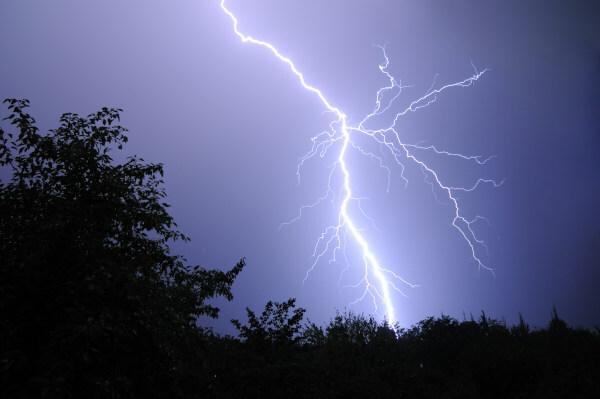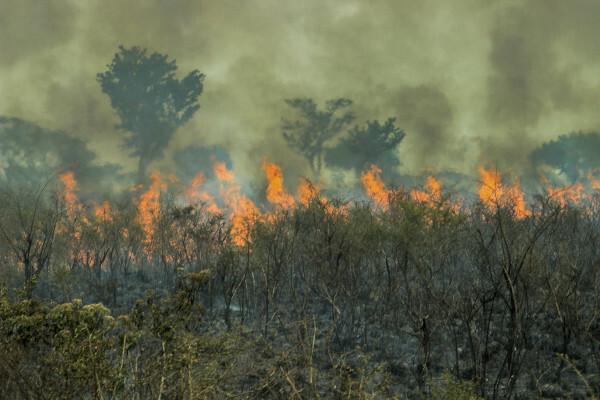You forest fires are environmental disasters that happen when fire gets out of control in an area covered by forest or forests. These occurrences may have natural causes, such as lightning strikes, or anthropic causes, such as the opening of areas for planting and grazing through the use of fire.
The consequences of forest fires affect flora, fauna, components of the natural environment and also on the population, who may suffer material losses and even lose their lives due to the direct action of fire or smoke. The prevention of forest fires depends on several factors, ranging from environmental education to changes in habits and land use practices.
Read too: After all, what is global warming and how can it impact life on Earth?
Summary on forest fires
Forest fires can be caused by natural phenomena or by human action.
The natural causes of forest fires are mainly lightning.
The anthropic causes are: irregular disposal of cigarette butts, cleaning of areas, carelessness with campfires, fire in the garbage and others.
Forest fires can be of three types: superficial, canopy or underground.
Countries such as Greece, Italy, Turkey, France, Canada, Australia and New Zealand have been affected by forest fires in recent decades.
The Amazon and Cerrado biomes are the most affected by forest fires in Brazil.
The worst forest fire in Brazil happened in the state of Paraná in 1963.
Forest fires directly harm flora and fauna, reduce nutritional quality and soil structure, pollute water and air and can contribute to worsening global warming global.
The prevention of forest fires involves environmental education, the use of new openings in areas that do not include fire, not allowing vehicles to pass over dry vegetation and other practices.
Main causes of forest fires
Forest fires are environmental disasters that can have natural or anthropogenic causes, that is, derived from the activity of human beings on the environment.
Natural causes of forest fires

The natural causes of forest fires are mainly electrical discharges (lightning) that fall on the vegetation. When this vegetation is very dry, the fire can spread quickly and get out of control, thus characterizing a forest fire. However, except in specific atmospheric conditions, lightning usually comes accompanied by rains and storms, which help control the incident.
Occasions like volcanic activity and very intense heat waves, combined with the absence of rain and the drying up of both the soil and the vegetation, can give rise to sparks that start forest fires. Despite this, human action is the main cause of this type of environmental disaster.
Anthropogenic causes of forest fires

Human activities are the main cause of fires in vegetation cover. These activities can be both voluntary, which are those conscious acts provoked by one's own will, and involuntary, the result of an unconscious action that can induce the appearance of fires that end up leaving the control. Voluntary acts are often associated with economic practices, such as the opening of planting and pasture areas or the production of charcoal.
Among the anthropogenic causes of forest fires we can quote:
- irregular disposal of cigarette butts that are still lit, which can start a fire when in contact with dry vegetation or soil;
- sparks from locomotives, cars or agricultural machinery;
- fire placed on rubbish or discarded objects in the bush;
- loss of control in the use of fire during the fires for clearing land, especially when clearing pastures, agricultural areas or areas intended for construction;
- fires made in camps that were not built correctly or not properly extinguished;
- fire deliberately started by people who, in fact, had the sole objective of starting a fire.
forest fires are classified according to how the fire spreads, taking into account the area in which he acts. The classification made in this way is widely used by the Fire Department and Civil Defense. There are, then, three types of forest fire occurrences:
Surface fires: fire spreads from the surface of the forest to an approximate height of 1.80 meters. The litter (leaf layer that is deposited on the forest floor), the organic matter layer, fallen branches, trunks and small species are affected.
Cup fires: the spread of fire occurs from the canopy of trees, spreading quickly due to the wind. They can gain ever-increasing proportions very quickly and are the most damaging fires to the fauna, flora and human populations that live nearby.
Underground fires: the spread of fire happens from underground, in the layer below the surface of the forest floor. It is a type of fire that is difficult to detect, and, depending on the amount of organic matter present in that portion of the soil, the fire has a long duration.
Check it out on our podcast: Fires in Brazil and in the world and their difference in relation to forest fires
Forest fires around the world
forest fires occurrences have become increasingly common. in different parts of the world, which is due, in part, to to climate change. These alterations provoked a transformation in the atmospheric dynamics and provided the occurrence of very dry weather that, due to in turn, cause vegetation and soil to dry out, making them more prone to the occurrence of fires and fires.
In August 2023, a huge forest fire took over Mauai, one of the islands that make up the US state of Hawaii. The Mauaí forest fire caused the death of more than a hundred people and left 1,300 people missing, in addition to thousands of homeless people. However, the numbers are still unknown, given that the city of Lahaina, with 12 thousand inhabitants, was destroyed by fire. The Hawaii wildfire is classified as the deadliest in recent US history.

In the last two decades, large forest fires have been recorded in locations like:
- West Coast and central region of the United States, as in the states of California, Washington, Oregon, Colorado and also in Hawaii;
- Canada;
- Greece;
- Italy;
- France;
- Australia;
- New Zealand;
- Mexico;
- Argentina;
And many other countries, on all continents of the world. This includes Brazil, as we will see later.
What is the biggest forest fire ever recorded in the world?
The biggest forest fire ever recorded in the world took place in Siberia, a region located in the north of Russian territory, and in the far east of Russia in the year 2003. The fire spread over the taiga vegetation, also known as the boreal forest, and burned approximately 22 million hectares of land. The intense emission of polluting gases into the atmosphere covered part of the Asian continent and also the European continent, causing devastating effects on atmospheric dynamics and in the ozone layer.
In 2021, the same regions were hit by a fire that devastated between 10 and 16 million hectares of boreal forest. Due to the increasingly severe forest fires raging in Russia, it is said that the loss of boreal forest is one of those that most contributes to the increase in the rate of forest loss in the world.
In the list of the biggest fires ever recorded in the world, the countries that appear most frequently are the United States, Canada and Australia.
Forest fires in Brazil
As in the rest of the planet, forest fires in Brazil have become increasingly recurrent and serious. In the year 2022, an area equivalent to the surface of the state of Acre|1| was consumed by the flames in the country, which corresponds to 163 thousand km², or 16.3 million hectares. The Amazon and the Cerrado were the two most affected biomes, being, not coincidentally, vegetation cover subject to to the action of economic activities such as agriculture, plant and mineral extraction, including the practice of mining.

In both biomes, but mostly in the amazon, O fire has been used as an aid in land clearing for the opening of new planting areas and also pasture. With regard to the states, the mapping of Monitor do Fogo, which integrates the MapBiomas platform, showed that Forest fires are most common in:
Mato Grosso;
For;
Amazon;
Roraima;
Amapá;
Rondônia;
and in the states of Matopiba (Maranhão, Tocantins, Piauí and Bahia).
In 1963, the country recorded its biggest forest fire.. It took place in the state of Paraná and devastated approximately 10% of its forest area, or 2 million hectares. Thousands of houses were destroyed by the fire, which affected areas in the north of Paraná, and 110 people were killed. The number of homeless people reached 5,700.
Know more: Fires in the Amazon — causes and consequences
Consequences of forest fires
Forest fires have devastating consequences for the environment, for atmospheric circulation and also for human beings. Below, we list some of the main effects caused by fires on forest cover.
Loss of biodiversity, as this affects both flora and fauna.
Reduction of the volume of nutrients present in the soil, directly affecting the vegetation. The soil can also become weakened and more susceptible to erosion.
Increased emission of polluting gases into the atmosphere, which impacts both the air quality in the affected areas, in the short term, and the climate conditions, in the long term.
Destruction of infrastructure such as roads, power transmission lines, buildings and houses located nearby.
Material losses, with the destruction of the assets of people living in affected areas.
Homeless people and deaths from both the direct action of fire and smoke.
How to prevent forest fires?
There are ways to prevent forest fires and prevent their serious consequences from affecting human and animal life and the vegetation in a given area. Environmental education and population awareness is one of the main ways to make that happen. Along with these measures, the following actions can be taken:
Do not light fires in the middle of vegetation, but in open areas. Monitor the development of these fires and put them out immediately after use with water or smothering them with earth.
Do not discard matches in wooded or forested areas.
Do not throw cigarette butts in the bush or forests, discarding them correctly in trash cans.
Avoid passing vehicles over vegetation, especially when it is dry.
Use of alternative methods of clearing the area, or even planting, so that there is no need to use fire.
Differences between forest fires and wildfires
Forest fires: are environmental disasters that happen when fire gets out of control in a certain area of vegetation cover of forest or forest, demanding a lot of time and resources for it to be extinguished. It can start from a fire.
Fires: are controlled practices that use fire to clear areas in the middle of vegetation for different purposes, either for the installation of new infrastructure (such as roads) or for land cultivation and land use as pasture.
Grades
|1| MAES, Jessica. Forest fires grow 14% in 2022, says report. Folha de S.Paulo, 30 Jan. 2023. Available in: https://www1.folha.uol.com.br/ambiente/2023/01/incendios-florestais-crescem-14-em-2022-aponta-relatorio.shtml.
Sources
AFP. The extent of the disaster in Hawaii is still unknown. metsul, 14 Aug. 2023. Available in: https://metsul.com/dimensao-do-desastre-no-havai-e-ainda-desconhecida/.
HONDERICH, Holly; MATZA, Max. Hawaii: 'Tourists are swimming in the same water our people died in three days earlier'. BBC News, 16 Aug. 2023. Available in: https://www.bbc.com/portuguese/articles/czkp0gpnzv4o.
IBAMA. Check out measures that can help prevent forest fires during the dry season. IBAMA, 01 Jun. 2020. Available in: https://www.gov.br/ibama/pt-br/assuntos/noticias/2020/confira-dicas-para-evitar-incendios-florestais-no-periodo-da-seca.
KUSPIOSZ, Douglas. 60 years ago, Paraná was burning. Folha de Londrina, 15 Aug. 2023. Available in: https://www.folhadelondrina.com.br/geral/ha-60-anos-o-parana-queimava-3238002e.html? d=1.
MAPBIOMAS. Fire Monitor. Available in: https://plataforma.brasil.mapbiomas.org/monitor-do-fogo.
PLOSCARIU, Iemima. Largest Brush And Forest Fires In Recorded History. world atlas, 15 Mar. 2018. Available in: https://www.worldatlas.com/articles/largest-brush-and-forest-fires-in-recorded-history.html.
SILVA, Romildo Gonçalves. Forest Fire Prevention and Fighting Manual. Brasilia: Brazilian Institute for the Environment and Renewable Natural Resources, 1998.
WHO. Wildfire. World Health Organization, [n.d.]. Available in: https://www.who.int/health-topics/wildfires#tab=tab_1.
YOUSIF, Nadine. Teams are expected to find 10 to 20 dead a day, says Hawaii governor. BBC News, 14 Aug. 2023. Available in: https://www.bbc.com/portuguese/articles/clj5jyez5ypo.
Source: Brazil School - https://brasilescola.uol.com.br/geografia/incendios-florestais.htm


